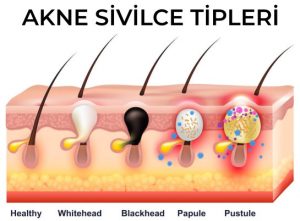 The earliest sign is an increased sebum secretion rate and a greasy appearance of the skin (seborrhoea). Comedones or blackheads are often accompanied by an oily appearance. They usually appear on the sides of the nose and on the forehead. Comedones are follicular plugs. They consist of hardened sebum and follicular waste material. In severely ill patients, the nodules liquefy and fuctuating cysts form. In reality, these lesions are pseudocysts because they lack epithelial layers. This is a severe acne.
The earliest sign is an increased sebum secretion rate and a greasy appearance of the skin (seborrhoea). Comedones or blackheads are often accompanied by an oily appearance. They usually appear on the sides of the nose and on the forehead. Comedones are follicular plugs. They consist of hardened sebum and follicular waste material. In severely ill patients, the nodules liquefy and fuctuating cysts form. In reality, these lesions are pseudocysts because they lack epithelial layers. This is a severe acne.
Face, cheeks, lower jaw, nose, forehead, back of the neck, front of the chest and shoulders are the most affected areas.
The natural tendency of the disease is to heal spontaneously. However, it is not clear when acne will heal. Mostly acne disappears at the age of 25. However, it may take much longer in some patients. Acne heals in summer. Sun and salt water improve the condition of most patients. However, heat does not improve. In a really hot and humid climate, acne can become inflamed and exudative.
 Scar tissue is the scars formed on the skin after an injury or a skin disease. It is characterised as a symptom that occurs as a result of the replacement of functional skin tissue with connective tissue during healing.
Scar tissue is the scars formed on the skin after an injury or a skin disease. It is characterised as a symptom that occurs as a result of the replacement of functional skin tissue with connective tissue during healing.
About 70% of the population has acne during adolescence. However, only 10% of them need medical help. It is very important to seek medical help in these patients. Otherwise, especially the face of the person may be covered with scar tissue. The psychological and social life of the person may be affected by this situation. These patients require medical treatment and long-term supportive therapy.
Histologically, the main feature is an extremely inflammatory folliculitis. In the early stage, a follicular plug can be seen. Later, inflammatory cell accumulation, histiocytes, giant cell granulomatous reaction are seen. In long-term lesions, there are fibrous tissue accumulations that initiate scar tissue. The formation of important inflammatory lesions in acne is thought to be the result of rupture of follicles.
Acne usually heals spontaneously. In the treatment of patients who do not heal, tetracycline group antibiotics and vitamin A derivative preparations are given. An important point here is that the unconscious use of both groups of drugs can lead to severe, permanent, life-threatening consequences. Unfortunately, tetracycline group antibiotics cause permanent bone marrow depression. As a result, permanent severe anaemia (anaemia) occurs. Unfortunately, there is no reversible treatment. Especially in young people, unconscious use of antibiotics in every acne-pimple outbreak results in lifelong weakness, fatigue, heart palpitations, and detachment from social and business life. In the treatment of acne that does not go away, if heavy scar tissues are formed on the face of the person, Vitamin A derivative preparations are used. As a result of unconscious use of these or their use without the control of a specialist physician, severe hepatodoxicity (liver poisoning) and liver failure may occur. Vitamin A derivatives are heavy drugs and must be administered under the supervision of a specialist physician after liver enzymes have been checked.
Thanks to the value given to phytotherapy by the Ministry of Health in our country in recent years, auxiliary phytotherapeutic applications are made in acne, face and body care, which are much easier, have no side effects and give the same result in every patient. These applications can be applied very easily and without side effects at home. With an average of 6 weeks of application, the person can easily get rid of all acne lesions. An acne-free life is possible without using drugs with side effects.
